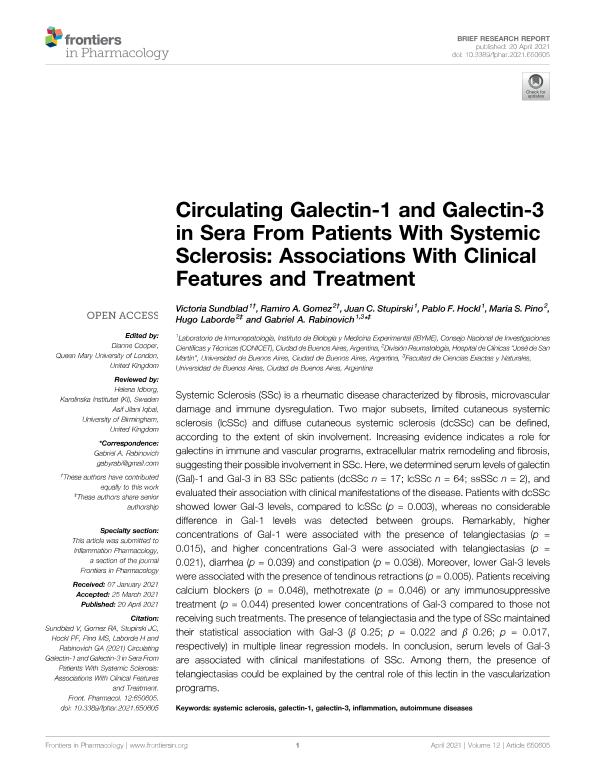Artículo
Circulating Galectin-1 and Galectin-3 in sera from patients with systemic sclerosis: associations with clinical features and treatment
Sundblad, Victoria ; Gomez, Ramiro A.; Stupirski, Juan Carlos
; Gomez, Ramiro A.; Stupirski, Juan Carlos ; Hockl, Pablo Francisco
; Hockl, Pablo Francisco ; Pino, Maria S.; Laborde, Hugo; Rabinovich, Gabriel Adrián
; Pino, Maria S.; Laborde, Hugo; Rabinovich, Gabriel Adrián
 ; Gomez, Ramiro A.; Stupirski, Juan Carlos
; Gomez, Ramiro A.; Stupirski, Juan Carlos ; Hockl, Pablo Francisco
; Hockl, Pablo Francisco ; Pino, Maria S.; Laborde, Hugo; Rabinovich, Gabriel Adrián
; Pino, Maria S.; Laborde, Hugo; Rabinovich, Gabriel Adrián
Fecha de publicación:
04/2021
Editorial:
Frontiers Media S.A.
Revista:
Frontiers in Pharmacology
ISSN:
1663-9812
Idioma:
Inglés
Tipo de recurso:
Artículo publicado
Clasificación temática:
Resumen
Systemic Sclerosis (SSc) is a rheumatic disease characterized by fibrosis, microvascular damage and immune dysregulation. Two major subsets, limited cutaneous systemic sclerosis (lcSSc) and diffuse cutaneous systemic sclerosis (dcSSc) can be defined, according to the extent of skin involvement. Increasing evidence indicates a role for galectins in immune and vascular programs, extracellular matrix remodeling and fibrosis, suggesting their possible involvement in SSc. Here, we determined serum levels of galectin (Gal)-1 and Gal-3 in 83 SSc patients (dcSSc n = 17; lcSSc n = 64; ssSSc n = 2), and evaluated their association with clinical manifestations of the disease. Patients with dcSSc showed lower Gal-3 levels, compared to lcSSc (p = 0.003), whereas no considerable difference in Gal-1 levels was detected between groups. Remarkably, higher concentrations of Gal-1 were associated with the presence of telangiectasias (p = 0.015), and higher concentrations Gal-3 were associated with telangiectasias (p = 0.021), diarrhea (p = 0.039) and constipation (p = 0.038). Moreover, lower Gal-3 levels were associated with the presence of tendinous retractions (p = 0.005). Patients receiving calcium blockers (p = 0.048), methotrexate (p = 0.046) or any immunosuppressive treatment (p = 0.044) presented lower concentrations of Gal-3 compared to those not receiving such treatments. The presence of telangiectasia and the type of SSc maintained their statistical association with Gal-3 (β 0.25; p = 0.022 and β 0.26; p = 0.017, respectively) in multiple linear regression models. In conclusion, serum levels of Gal-3 are associated with clinical manifestations of SSc. Among them, the presence of telangiectasias could be explained by the central role of this lectin in the vascularization programs.
Palabras clave:
AUTOIMMUNE DISEASES
,
GALECTIN-1
,
GALECTIN-3
,
INFLAMMATION
,
SYSTEMIC SCLEROSIS
Archivos asociados
Licencia
Identificadores
Colecciones
Articulos(IBYME)
Articulos de INST.DE BIOLOGIA Y MEDICINA EXPERIMENTAL (I)
Articulos de INST.DE BIOLOGIA Y MEDICINA EXPERIMENTAL (I)
Citación
Sundblad, Victoria; Gomez, Ramiro A.; Stupirski, Juan Carlos; Hockl, Pablo Francisco; Pino, Maria S.; et al.; Circulating Galectin-1 and Galectin-3 in sera from patients with systemic sclerosis: associations with clinical features and treatment; Frontiers Media S.A.; Frontiers in Pharmacology; 12; 650605; 4-2021; 1-8
Compartir
Altmétricas



